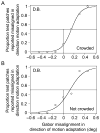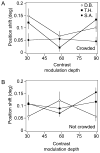Position shifts following crowded second-order motion adaptation reveal processing of local and global motion without awareness
- PMID: 18217830
- PMCID: PMC3137899
- DOI: 10.1167/7.2.15
Position shifts following crowded second-order motion adaptation reveal processing of local and global motion without awareness
Abstract
Adaptation to first-order (luminance defined) motion produces not only a motion aftereffect but also a position aftereffect, in which a target pattern's perceived location is shifted opposite the direction of adaptation. These aftereffects can occur passively (when the direction of motion adaptation cannot be detected) and remotely (when the target is not at the site of adaptation). Although second-order (contrast defined) motion produces these aftereffects, it is unclear whether they can occur passively or remotely. To address these questions, we conducted two experiments. In the first, we used crowding to remove a local adapter's second-order motion from awareness and still found a significant position aftereffect. In the second experiment, we found that the direction of motion in one region of a crowded array could produce a position aftereffect in an unadapted, spatially separated region of the crowded array. The results suggest that second-order motion influences perceived position over a large spatial range even without awareness.
Figures







Similar articles
-
Second-order motion without awareness: passive adaptation to second-order motion produces a motion aftereffect.Vision Res. 2007 Feb;47(4):569-79. doi: 10.1016/j.visres.2006.09.016. Epub 2007 Jan 10. Vision Res. 2007. PMID: 17217978 Free PMC article.
-
Separate motion-detecting mechanisms for first- and second-order patterns revealed by rapid forms of visual motion priming and motion aftereffect.J Vis. 2009 Oct 28;9(11):27.1-16. doi: 10.1167/9.11.27. J Vis. 2009. PMID: 20053090
-
Dynamics of spatial distortions reveal multiple time scales of motion adaptation.J Neurophysiol. 2009 Dec;102(6):3619-26. doi: 10.1152/jn.00548.2009. Epub 2009 Oct 7. J Neurophysiol. 2009. PMID: 19812288 Free PMC article.
-
Invisible Adaptation: The Effect of Awareness on the Strength of the Motion Aftereffect.Perception. 2020 Aug;49(8):835-857. doi: 10.1177/0301006620936853. Epub 2020 Jun 30. Perception. 2020. PMID: 32605425
-
[MOTION AFTEREFFECT AS A UNIVERSAL PHENOMENON IN SENSORY SYSTEMS INVOLVED IN SPACE ORIENTATION. II. AUDITORY MOTION AFTEREFFECT].Zh Evol Biokhim Fiziol. 2015 May-Jun;51(3):145-53. Zh Evol Biokhim Fiziol. 2015. PMID: 26281216 Review. Russian.
Cited by
-
Crowding, grouping, and object recognition: A matter of appearance.J Vis. 2015;15(6):5. doi: 10.1167/15.6.5. J Vis. 2015. PMID: 26024452 Free PMC article.
-
Voluntary attention modulates motion-induced mislocalization.J Vis. 2011 Mar 17;11(3):12. doi: 10.1167/11.3.12. J Vis. 2011. PMID: 21415228 Free PMC article.
-
Shared attentional resources for global and local motion processing.J Vis. 2007 Jul 24;7(10):10.1-10. doi: 10.1167/7.10.10. J Vis. 2007. PMID: 17997679 Free PMC article.
-
Unifying Visual Space Across the Left and Right Hemifields.Psychol Sci. 2018 Mar;29(3):356-369. doi: 10.1177/0956797617735534. Epub 2018 Jan 18. Psychol Sci. 2018. PMID: 29346029 Free PMC article.
-
Effects of crowding and attention on high-levels of motion processing and motion adaptation.PLoS One. 2015 Jan 23;10(1):e0117233. doi: 10.1371/journal.pone.0117233. eCollection 2015. PLoS One. 2015. PMID: 25615577 Free PMC article.
References
-
- Aghdaee SM. Adaptation to spiral motion in crowding condition. Perception. 2005;34:155–162. - PubMed
-
- Aghdaee SM, Zandvakili A. Adaptation to spiral motion: Global but not local motion detectors are modulated by attention. Vision Research. 2005;45:1099–1105. - PubMed
-
- Allen HA, Ledgeway T. Attentional modulation of threshold sensitivity to first-order motion and second-order motion patterns. Vision Research. 2003;43:2927–2936. - PubMed
-
- Anstis SM, Cavanagh P. A minimum motion technique for judging equiluminance. In: Mollon J, Sharpe RT, editors. Color vision: Physiology and psychophysics. London: Academic Press; 1983. pp. 155–166.
-
- Anstis SM, Reinhardt-Rutland AH. Interactions between motion aftereffects and induced movement. Vision Research. 1976;16:1391–1394. - PubMed
MeSH terms
Grants and funding
LinkOut - more resources
Full Text Sources

